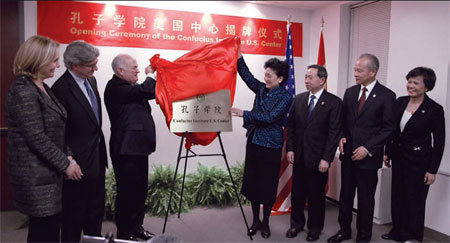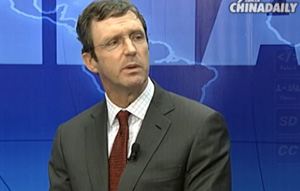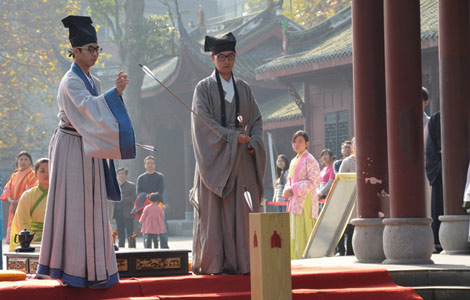Confucius Institute meets a need
Updated: 2013-11-22 14:39
By Cai Chunying (China Daily USA)
|
||||||||
|
Chinese Vice-Premier Liu Yandong (center) and George Washington University President Steven Knapp unveiled the plaque of Confucius Institute US Center in Washington on Wednesday. To Knapp's left are Josette Sheeran, president of Asia Society, and John Thornton, chairman of the board of trustees of the Brookings Institution. To Liu's right are China's Minister of Education Yuan Guiren, Chinese Ambassador to the US Cui Tiankai, and Office of Chinese Language Council International Director-General Xu Lin. Sun Chenbei / China Daily |
Chinese Vice-Premier Liu Yandong took a major step in strengthening the Confucius Institute in the United States, dedicating a new center in the nation's capital and promising support for its mission of promoting the teaching of Chinese language and cultural exchanges, Cai Chunying reports from Washington.
To the 98 Confucius Institutes at American universities and colleges, this week's visit to the US by Chinese Vice-Premier Liu Yandong has opened a new chapter.
She officially launched the Confucius Institute US Center in Washington, a regional headquarters dedicated to helping schools and the non-profit institutes achieve their shared goal: to promote Chinese language learning and cultural exchanges.
Liu is in the US to co-host, with Secretary of State John Kerry, the fourth China-US High-Level Consultation on People-to-People Exchange (CPE), an initiative devoted to enhancing understanding and collaboration among citizens of the two countries.
Praising Confucius Institute as a manifesto of effective cultural exchange, Liu said she would give the initiative greater prominence in her discussion with Kerry, and she promised to provide more support.
This was welcomed news for Xu Lin, director-general of the Office of Chinese Language Council International - more commonly known for its Chinese abbreviation Hanban - which is also the headquarters for Confucius Institutes worldwide.
Under Xu's leadership, 435 Confucius Institutes and 644 Confucius Classrooms have been launched in 117 countries and regions since 2004 when the first one was established in South Korea. About 500 institutions, including 70 or so in the US, have applied for the establishment of a Confucius Institute or Classrooms.
Hanban provides each institute with startup funding, Chinese language teaching materials, and language teachers, while the host university provides infrastructure, administrative support and accommodations for visiting teachers. Hanban also appoints a Chinese partner university for the institute, which sends a Chinese director to work together with the director appointed by the American side.
US No 1
The US leads the world in the total number of Confucius Institutes with 98. Located across the street from the Brookings Institution in the nation's capital, the new US Center will serve as a source of information and communication for US government agencies and civic organizations, and a coordination center to promote cooperation and exchanges among all the Confucius Institutes in the country.
Building overseas institutes to promote a country's language and culture is nothing new. Great Britain has more than 190 British Councils in more than 100 countries, and Germany's Goethe Institute is in nearly 160 locations worldwide. Alliance Franaise was launched by France 130 years ago and now has the largest network of around 1,040 branches globally.
The British Council and Goethe Institute are funded by their respective governments, while Alliance Franaise is more of a private institution with subsidies from the French government.
"The US does this too," said David Keitges, director of International Student and Scholar Services at the Miami University of Ohio, who also serves as the interim director of the Confucius Institute there that was established in 2007. "For a long time we had US libraries abroad, and the musician Louis Armstrong would tour around the world promoting good will and teaching culture."
To C. D. Mote, former president of the University of Maryland (UMD) who played an essential role in placing the first Confucius Institute in the US, or the second in the world, at the school, China's establishing the institutes mostly within universities in a foreign country is an innovation.
"The other international programs are served rather more as a cultural and diplomatic mission of the country," said Mote. "The Confucius Institute is much more embedded in the countries they serve. Each CI program comes out of the country. They do not come out of Beijing."
Mote is referring to the diversity of the Confucius Institutes in the US and that each designs its own programs based on the resources and strength of the hosting university with little involvement from the institute's headquarters.
Stanford University's Confucius Institute, established in 2010, leans more toward the research side of Chinese culture and endows a professorship and two graduate fellowships. Newly formed Confucius Institute at the University of California at Davis is devoted to teaching Chinese cuisine art. Pfeiffer University's Confucius Institute finds its comfort zone in teaching calligraphy. Georgia State University takes pride in its Confucius Institute's offering of business Chinese courses, to name just a few.
Mote's observation on the independence of each Confucius Institute is echoed by Richard Saller, dean of the School of Humanities and Sciences at Stanford University and director of its Confucius Institute.
"I would say we've had a mutually respectful relationship, we've done things in the way we've done with other countries. They provided funds, we developed the program," he said. "We've absolutely benefited from having the Confucius Institute on campus. Our program in Chinese studies is stronger now. The US and our students stand to gain a lot in learning and understanding more about Chinese culture. I'm just glad to offer a stronger program as a result of Hanban's contribution."

 Oil pipeline blast leaves 22 dead in E China
Oil pipeline blast leaves 22 dead in E China
 Good couples get better
Good couples get better
 More than 9m Syrians need humanitarian aid
More than 9m Syrians need humanitarian aid
 50th anniversary of the assassination of Kennedy
50th anniversary of the assassination of Kennedy Blueprint tightens EU links
Blueprint tightens EU links
 Beckham promotes bodywear in Shanghai
Beckham promotes bodywear in Shanghai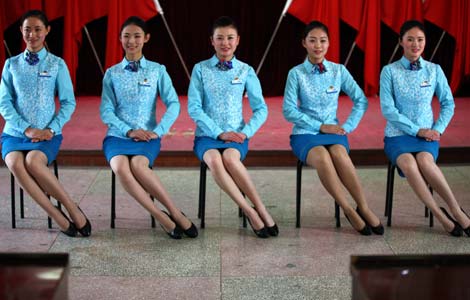
 Service seminar for E China train attendants
Service seminar for E China train attendants
 Kennedy cousin Skakel poised for prison release
Kennedy cousin Skakel poised for prison release
Most Viewed
Editor's Picks

|
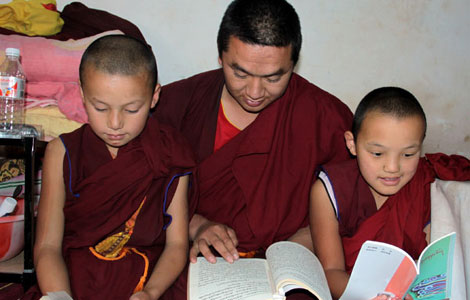
|

|

|

|

|
Today's Top News
Wang named Asia's businessman of the year
Bitcoin rollercoaster hits China
US President sets new date for Asia visit
Bid to boost people ties
Manufacturing PMI seen moderating in Nov
Kennedy cousin Skakel poised for prison release
'Tapering' of QE would benefit world
Blueprint tightens EU links
US Weekly

|

|
